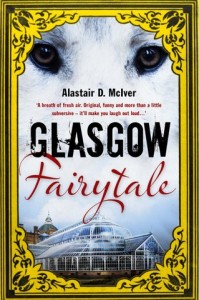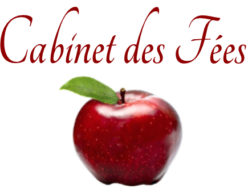 Welcome to Glasgow, where the only option is to live happily ever after. Glasgow Fairytale, by Alastair D. McIver, is a wild ride through some of the most well-known stories in the fairy tale canon. By the second line I was giggling and by page three I knew I’d struck gold. In fact, this book is so funny that it was almost impossible to write a review. Every time I thought about the story I started laughing. Set in a very extraordinary Glasgow, where magic happens and a King rules by way of the television, the story begins with the appearance of a wee mysterious man in a scene those of us familiar with public transport in major cities will certainly recognize. From there it goes on to make a delightful mockery of almost everything – from media moguls to immigration rules to footballers. No one is safe here.
Welcome to Glasgow, where the only option is to live happily ever after. Glasgow Fairytale, by Alastair D. McIver, is a wild ride through some of the most well-known stories in the fairy tale canon. By the second line I was giggling and by page three I knew I’d struck gold. In fact, this book is so funny that it was almost impossible to write a review. Every time I thought about the story I started laughing. Set in a very extraordinary Glasgow, where magic happens and a King rules by way of the television, the story begins with the appearance of a wee mysterious man in a scene those of us familiar with public transport in major cities will certainly recognize. From there it goes on to make a delightful mockery of almost everything – from media moguls to immigration rules to footballers. No one is safe here.
It is possible that the humour in this book will not be taken as such by an audience unfamiliar with the Glaswegian attitude. More is the pity, because frankly this book provides a hilarious look at reality, transforming the characters from an assortment of fairy tales into people many of us have dealt with in our personal lives (or seen on TV). Here is Rapunzel as an asylum seeker, Prince Charming as a football star, Cinderella as a foster child and the big bad wolf as, of course, the big bad wolf, except now he’s protected by the European Union Charter of Fundamental Rights (as are the three little pigs). Jack and Jill, Red Riding Hood, Thumbelina, the Frog Prince, the beanstalk, the magic mirror, an evil King and Rumpelstiltskin are alive and well in Glasgow, although once they’ve finished with it, Glasgow may never be the same again.
Like with all fairy tales, the story defies its placement. These characters could be, and are, found everywhere. And yet this fairy tale is also decidedly Glaswegian. The dialogue is thick with the local accent and the references to football rivalries might be lost on some, but none of this detracts from the story itself. At first it is broken into scenes that flash quickly from one to another, each one building up to that sublime moment when everything and everyone is deftly brought together for that perfect good vs. evil conclusion inherent in all fairy tales. The plot is strong and never failed to hold my attention, and every time I was sure the cast of characters had been set, another one popped up in the mix.
When people say a fairy tale has been turned upside down and inside out, they must mean this fairy tale, this wonderful, outrageous and delightfully subversive collective of lovable, spiteful and despicable characters that make this story unlike any fairy tale you’ve read before. This is a cunning, witty book and one I can’t recommend enough.
